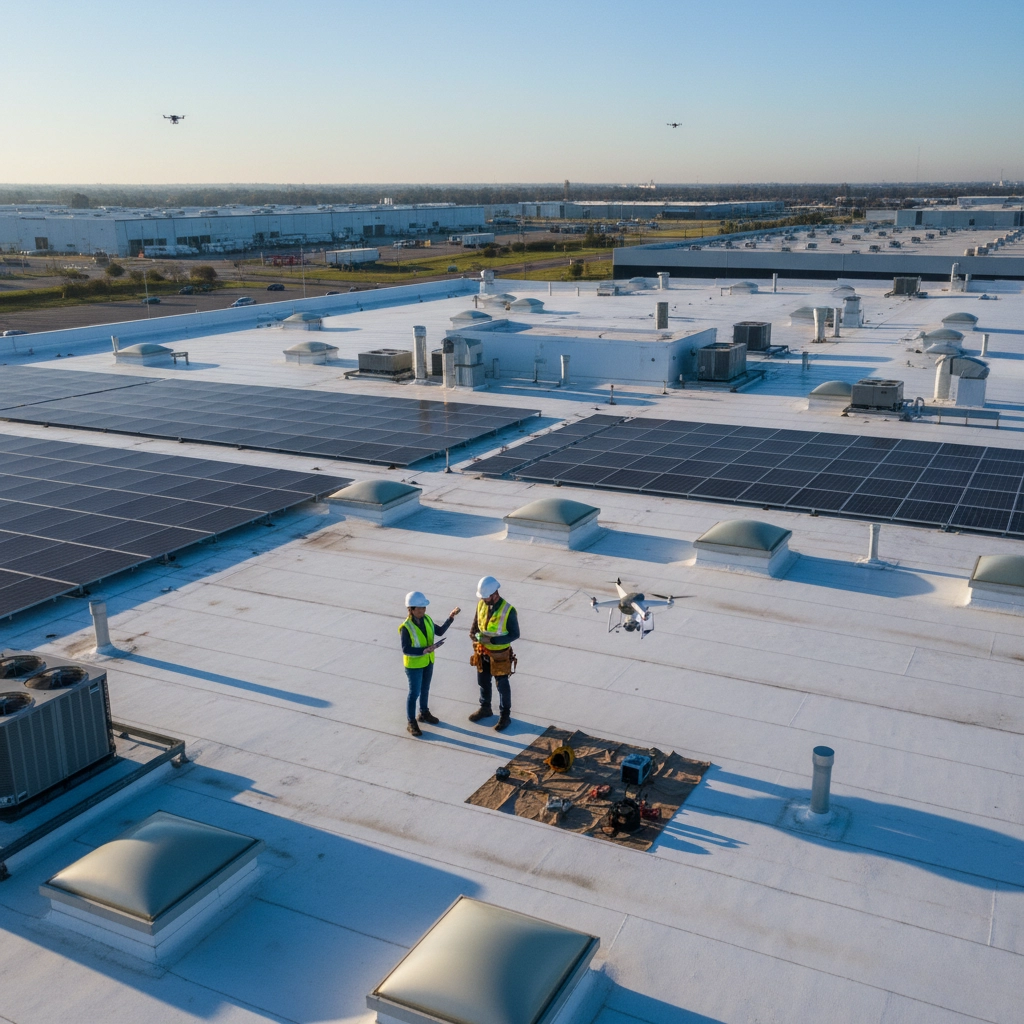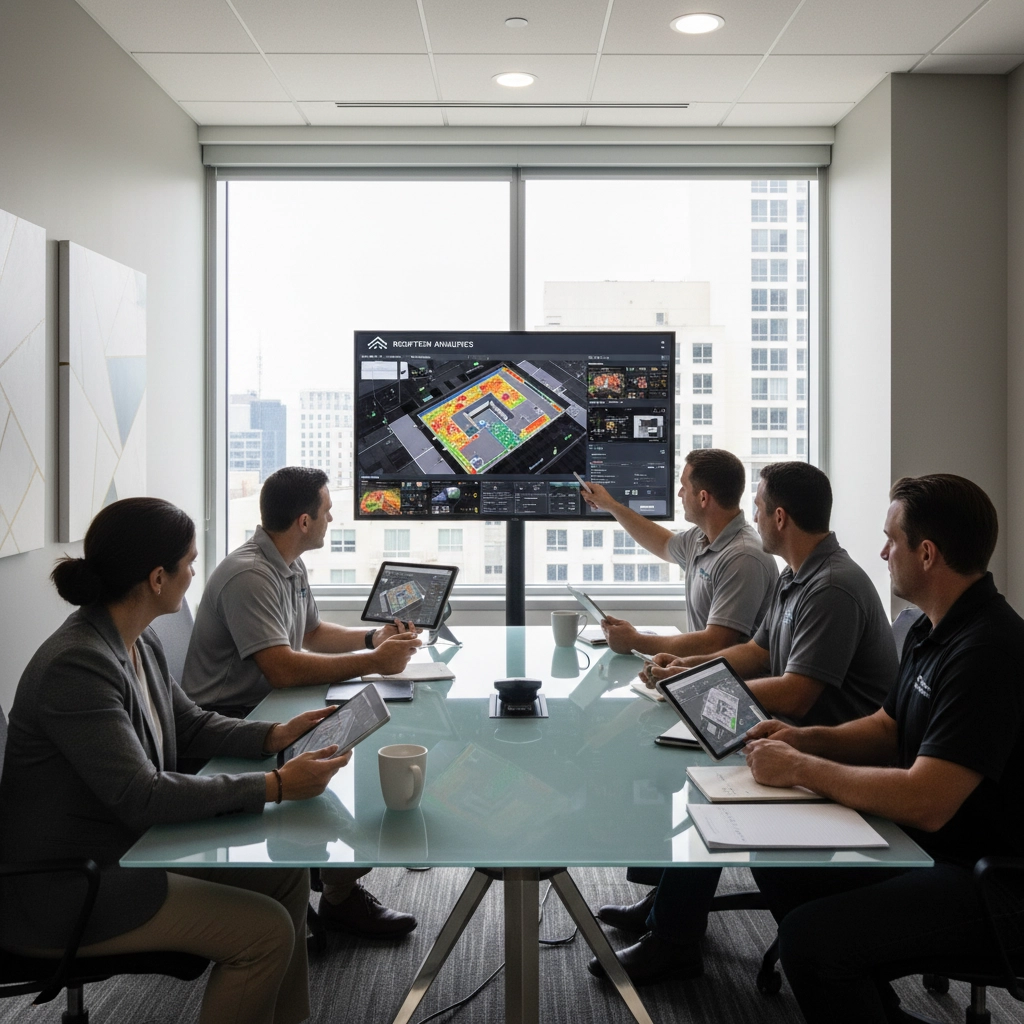
Picture this: It's mid-January 2026, and your CFO calls an emergency meeting. The roof over your main warehouse is leaking again: this time badly enough to threaten inventory worth hundreds of thousands of dollars. The repair estimate? $75,000. And that's just to stop the bleeding until you can plan a proper replacement in the spring.
Sound familiar? You're not alone. According to industry data, nearly 40% of commercial property emergencies stem from roofing failures that could have been predicted and prevented with proper planning and budgeting.
Here's the thing: building a predictable commercial roofing budget isn't rocket science, but it does require a strategic approach that goes beyond simply setting aside money and hoping for the best. The most successful facility managers, CFOs, and asset management directors we work with treat their roofs like any other critical business asset: with data-driven maintenance forecasting, capital planning, and proactive roof asset management.
Let's walk through exactly how to build a bulletproof roofing budget for 2026 that keeps emergency costs at bay and gives you the predictability your organization needs.
Think of your roof like a fleet of vehicles. You wouldn't wait for a truck to break down on the highway before checking its maintenance history, would you? The same principle applies to commercial roofing budget planning.
Your first step is conducting a thorough roof condition assessment across all your properties. This isn't a casual walk-around: we're talking about a systematic evaluation that documents:
This data becomes the foundation of your roof asset management strategy. Without it, you're essentially flying blind when it comes to maintenance forecasting and capital planning.
Here's what many facility managers miss: a comprehensive assessment reveals not just what needs immediate attention, but what will likely need attention in 12, 24, and 36 months. That predictive insight is pure gold when it comes to budget planning.
We've seen too many organizations get blindsided by "sudden" roof failures that were actually years in the making. The warning signs were there: they just weren't being systematically tracked and analyzed.
Gone are the days when roof management meant keeping a manila folder with a few inspection reports. Today's most successful commercial property managers use digital platforms that turn inspection data into actionable forecasting intelligence.
Modern roof asset management systems can predict maintenance needs with remarkable accuracy by analyzing:
Think of these digital tools as your early warning system. Instead of reacting to problems, you're anticipating them and budgeting accordingly.
For example, holding company manages a portfolio of 23 industrial facilities across Texas and Oklahoma. By implementing digital roof management tracking, they reduced emergency repair costs by 60% in their first year while improving their maintenance forecasting accuracy to within 8% of actual costs.
The key is choosing a system that integrates inspection data, maintenance history, and cost tracking in one platform. This gives you the complete picture needed for accurate commercial roofing budget planning.
Let's talk numbers, because accurate maintenance forecasting requires understanding the economic landscape you're planning in.
Material costs in 2026 are expected to see modest increases: typically 3-5% over 2025 levels: driven primarily by energy costs and transportation. However, labor costs tell a different story. Skilled commercial roofing labor is increasingly scarce, and we're seeing wage inflation in the 8-12% range in many markets.
Here's where strategic timing becomes crucial to your commercial roofing budget. Projects scheduled during peak season (spring and early summer) can cost 15-20% more than identical work performed in late fall or winter. That's not just due to demand: it's also about contractor availability and the leverage you have in negotiations.

Smart capital planning means aligning your project timeline with both your building needs and market conditions. If your roof assessment shows you have 18 months of useful life remaining, you might choose to schedule replacement for late 2025 to avoid both peak season pricing and potential 2026 cost increases.
Material selection also plays a major role in your long-term commercial roofing budget. While premium systems cost more upfront, their extended warranties and lower maintenance requirements often deliver better total cost of ownership. Think TPO systems with 20-year warranties versus modified bitumen with 10-year coverage: the math usually favors the higher initial investment.
Here's where most organizations get it wrong: they treat roofing as an annual expense instead of a multi-year capital investment. The most successful roof asset management approaches span 3-5 years, allowing for strategic scheduling and better cash flow management.
Your multi-year capital planning should categorize your roof portfolio into three buckets:
Immediate Action Required (0-12 months): Roofs showing critical wear, persistent leaks, or safety concerns. These go into your 2026 emergency reserve fund because waiting isn't an option.
Planned Replacement (1-3 years): Systems approaching end of useful life but still functional. This is your sweet spot for strategic scheduling and competitive bidding.
Preventive Maintenance (3-5 years): Newer systems that benefit from proactive care to extend their lifespan and maintain warranty coverage.
This tiered approach gives you incredible flexibility in maintenance forecasting and budget allocation. Instead of scrambling to fund a $200,000 roof replacement, you can plan for it two years in advance, negotiate better pricing, and time the project for optimal weather conditions.
One facility manager we work with manages this beautifully. She maintains a rolling 60-month roof replacement schedule that's updated annually based on inspection data. Her organization hasn't had an emergency roof expense in over four years, and its average project cost is 18% below market rates due to strategic timing and advance planning.
Think of preventive maintenance as insurance for your commercial roofing budget. The cost of routine care: drain clearing, minor repairs, coating touch-ups, is a fraction of what you'll pay for emergency interventions.
A well-designed maintenance program should include:
Seasonal Inspections: Post-storm assessments and pre-winter preparations that catch small issues before they become expensive problems.
Drainage System Maintenance: Regular cleaning and minor repairs that prevent the water damage responsible for 60% of premature roof failures.
Membrane Care: Proactive seam sealing, coating refresh, and minor patching that extends system life by 3-5 years on average.
Documentation and Tracking: Detailed records that support warranty claims and provide data for future maintenance forecasting.
The ROI on preventive maintenance is remarkable. Industry studies show that every dollar spent on proactive care saves $4-6 in avoided emergency repairs. More importantly for your commercial roofing budget, it makes your costs predictable instead of reactive.
We recommend budgeting $0.15-0.25 per square foot annually for comprehensive preventive maintenance, depending on your roof type and local climate conditions. That investment typically extends roof life by 20-30% while dramatically reducing the likelihood of emergency expenses.
Even with the best roof asset management and maintenance forecasting, you need emergency reserves. The question is: how much?
Industry best practice suggests maintaining an emergency fund equal to 5-8% of your total roof replacement value across your portfolio. For most organizations, this provides adequate coverage for unexpected storm damage, sudden membrane failures, or code compliance requirements that arise during planned maintenance.
However, your specific reserve requirements depend on several factors:
The key is treating your emergency fund as insurance, not a slush fund. These dollars should be readily accessible but clearly designated for genuine roofing emergencies: not routine maintenance that should have been planned and budgeted in advance.
Your commercial roofing budget is only as good as the contractors providing your estimates and timeline projections. This is where many organizations unknowingly sabotage their own planning efforts.
Here's the uncomfortable truth: not all roofing contractors are equipped to support serious capital planning and maintenance forecasting. The guy who can patch a leak might not be the right partner for multi-year roof asset management.
Look for contractors who demonstrate:
Data-Driven Assessment Capabilities: Modern inspection technology, detailed reporting, and accurate remaining life projections.
Transparent Pricing Models: Clear breakdowns of material, labor, and overhead costs that allow for accurate budget planning.
Multi-Year Planning Experience: A track record of helping clients develop and execute long-term roofing strategies.
Warranty and Service Support: Comprehensive coverage and responsive service that reduces your emergency expense risk.

At TriVAN Roofing, we've seen too many facility managers get burned by contractors who promise low prices but deliver poor forecasting, unrealistic timelines, or substandard work that creates future budget surprises. The lowest bid rarely delivers the lowest total cost of ownership.
Instead, focus on contractors who can become genuine partners in your roof asset management strategy. They should understand your business needs, provide accurate maintenance forecasting, and help you optimize timing and material selection for your specific situation.
Modern commercial roofing budget management increasingly relies on technology integration that provides real-time performance data and predictive insights.
Smart roof monitoring systems can track:
This continuous monitoring transforms your maintenance forecasting from reactive to predictive. Instead of discovering problems during annual inspections, you're alerted to developing issues in real-time.
The cost of these monitoring systems, typically $2-4 per square foot for comprehensive coverage, pays for itself through improved maintenance timing and reduced emergency interventions. More importantly for capital planning, the data helps you optimize replacement timing and material selection based on actual performance rather than theoretical projections.
Your commercial roofing budget shouldn't exist in isolation from your organization's broader financial strategies. Several tax benefits and financing options can significantly impact your effective roofing costs:
Section 179 Depreciation: Allows immediate expensing of roof improvements up to annual limits, providing substantial tax benefits for qualifying projects.
Energy Efficiency Incentives: Federal and state programs that provide credits or rebates for high-performance roofing systems.
Financing Options: Equipment financing and lease arrangements that can improve cash flow while spreading costs over the system's useful life.
Insurance Considerations: Premium reductions available for impact-resistant systems or facilities with comprehensive maintenance programs.
Smart facility managers coordinate their roof asset management strategy with their finance and tax teams to optimize these benefits. The timing of projects, selection of materials, and structuring of contracts all affect your organization's total cost picture.
A predictable commercial roofing budget requires accountability mechanisms that ensure your strategy stays on track. Establish clear metrics for:
Cost Accuracy: How close your actual expenses come to budgeted amounts, with targets typically within 5-8% for planned work.
Emergency Frequency: Number of unplanned roof interventions, with world-class facility management achieving less than one emergency per 50 roof years.
Maintenance ROI: Documented savings from preventive programs versus historical reactive costs.
Contractor Performance: Timeline adherence, warranty claims, and long-term system performance.
Regular review of these metrics allows for continuous improvement in your maintenance forecasting and capital planning processes. The most successful organizations treat their roof asset management as an evolving discipline, not a set-and-forget budget line item.
Ready to build your bulletproof commercial roofing budget for 2026? Here's your step-by-step action plan:
The difference between organizations that control their roofing costs and those that get controlled by them comes down to planning, data, and partnerships. Emergency expenses aren't truly emergencies: they're just planning failures in disguise.
Your roof is one of your facility's most important assets. Treat it like one, and it will reward you with decades of predictable, manageable expenses instead of budget-busting surprises.
Think of it this way: you wouldn't drive cross-country without checking your tires, oil, and engine condition first. The same logic applies to your commercial roofing budget: a little preparation goes a long way toward avoiding expensive roadside assistance calls.
Ready to build your predictable roofing budget for 2026? TriVAN Roofing has helped facility managers across Texas and Oklahoma develop data-driven roof asset management strategies that eliminate emergency costs and optimize capital planning. Our comprehensive assessment and forecasting services give you the insights needed for accurate maintenance budgeting and strategic decision-making.